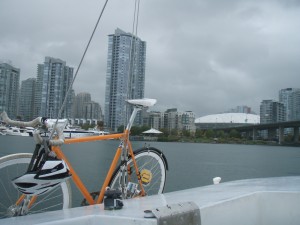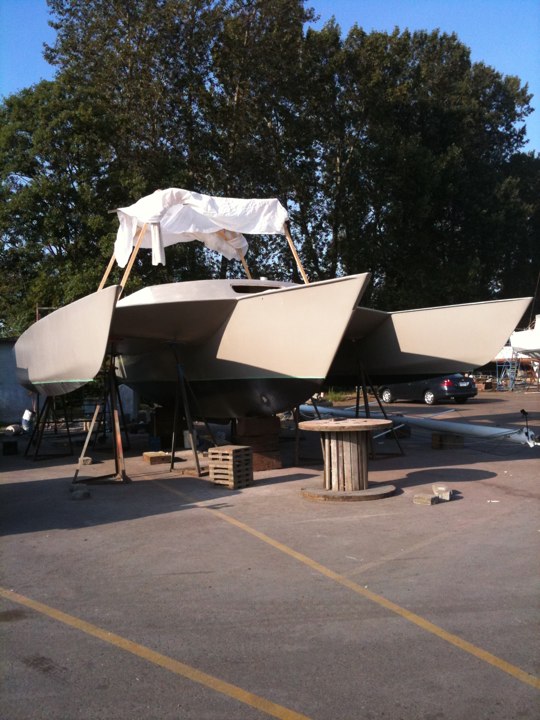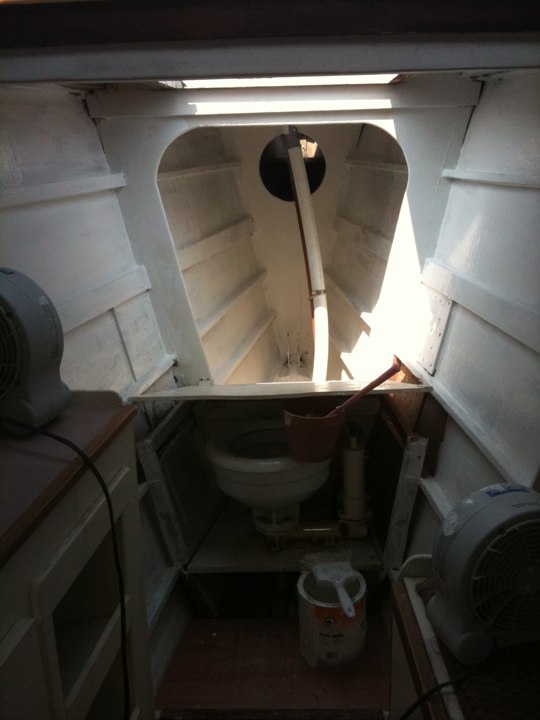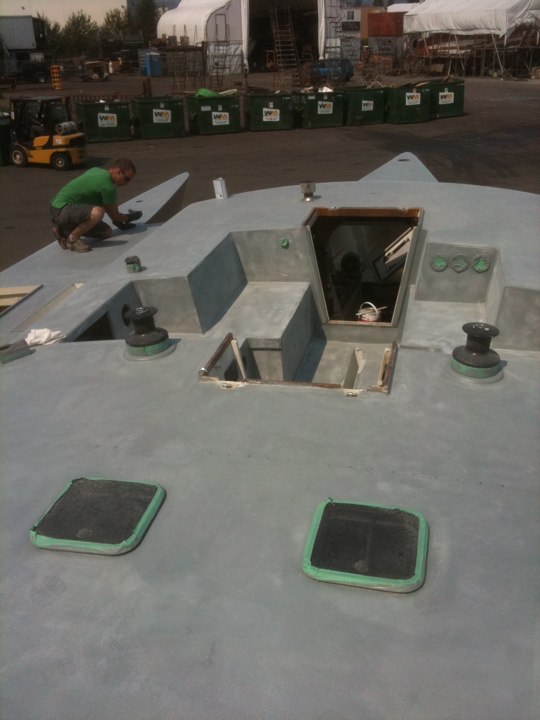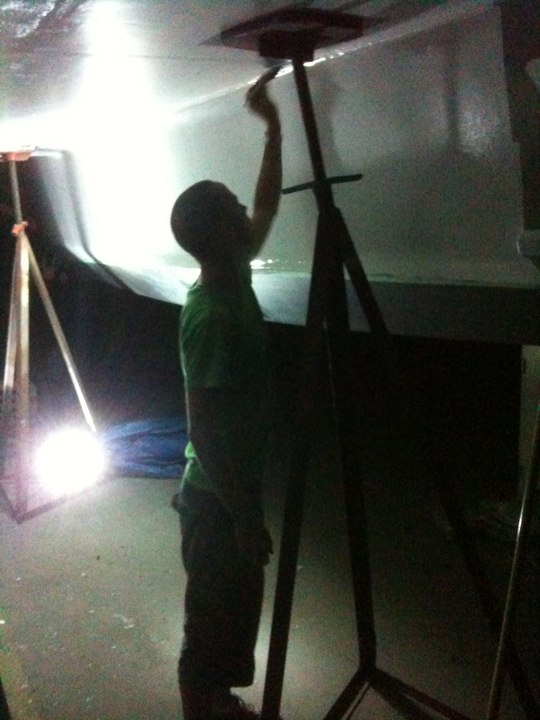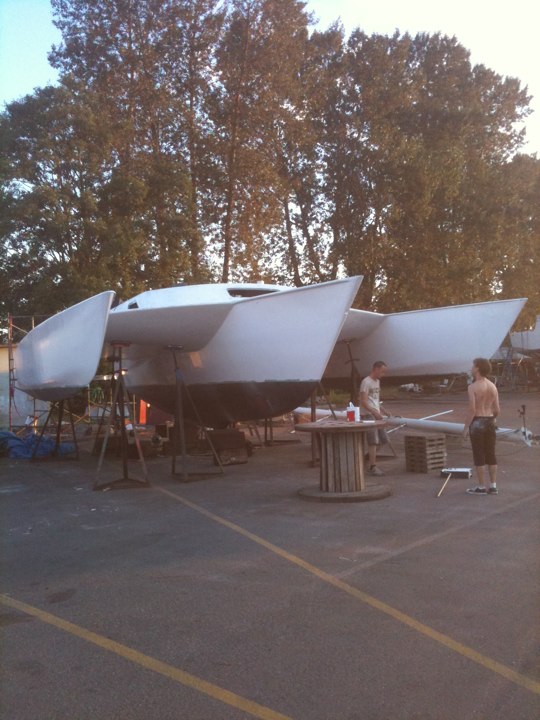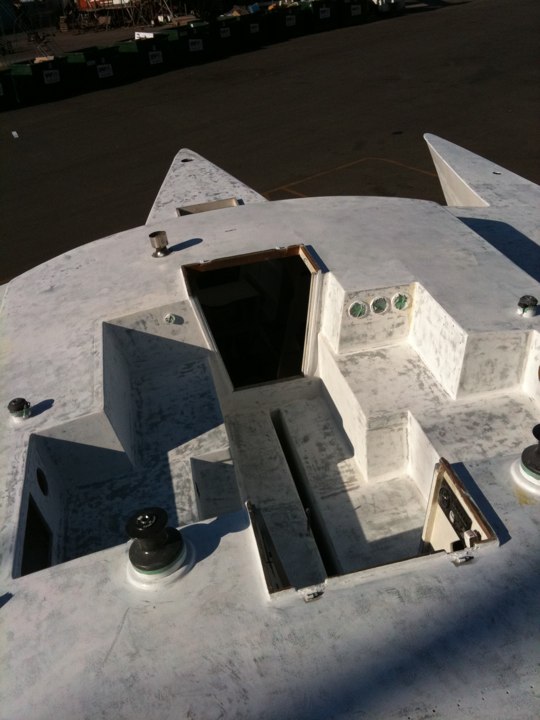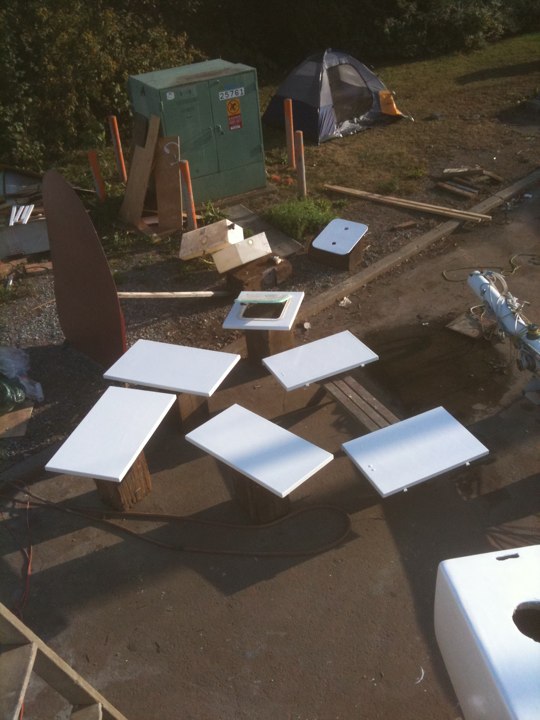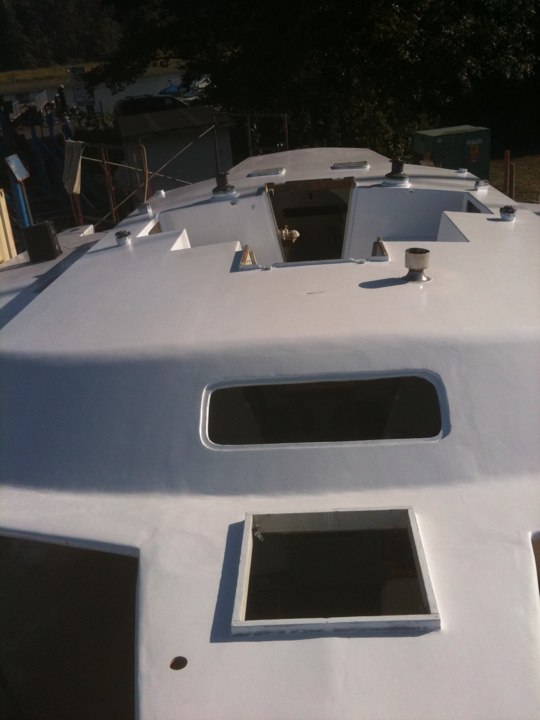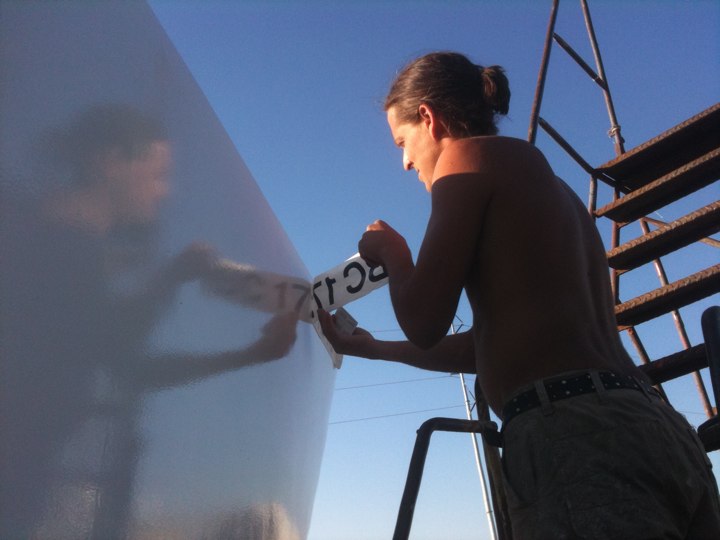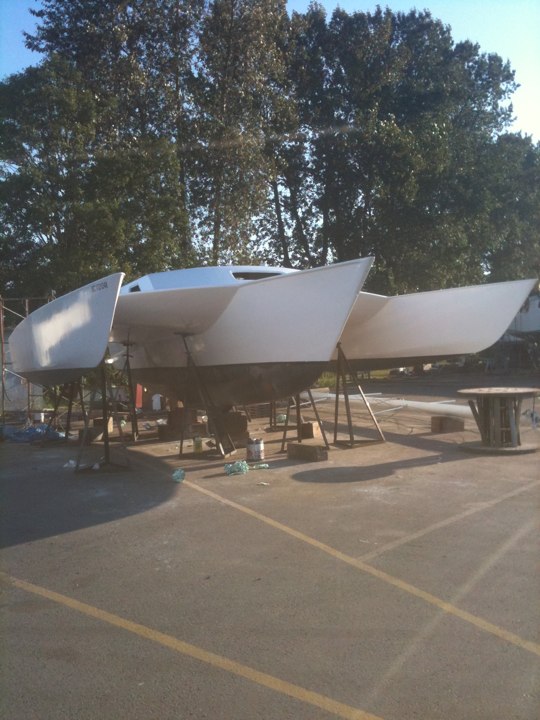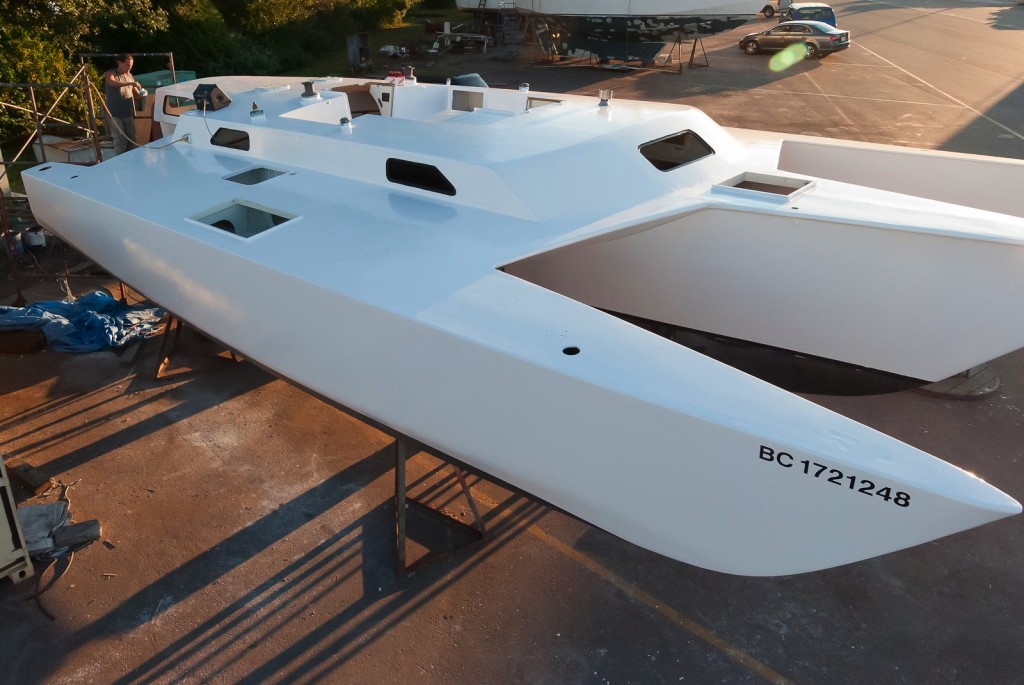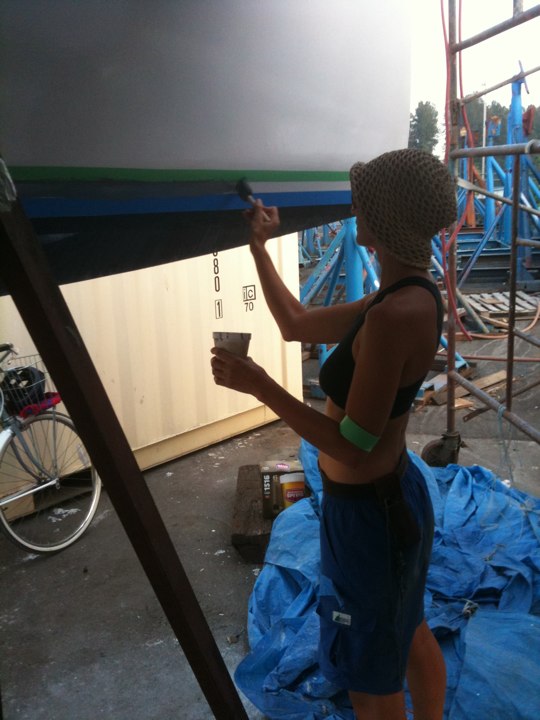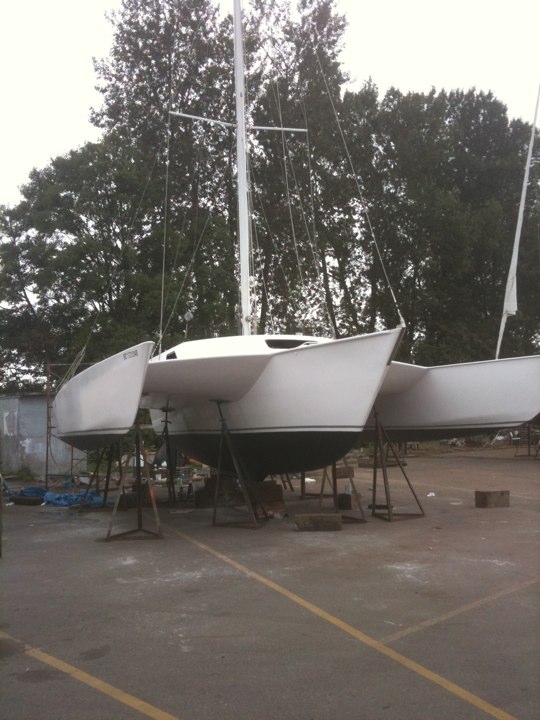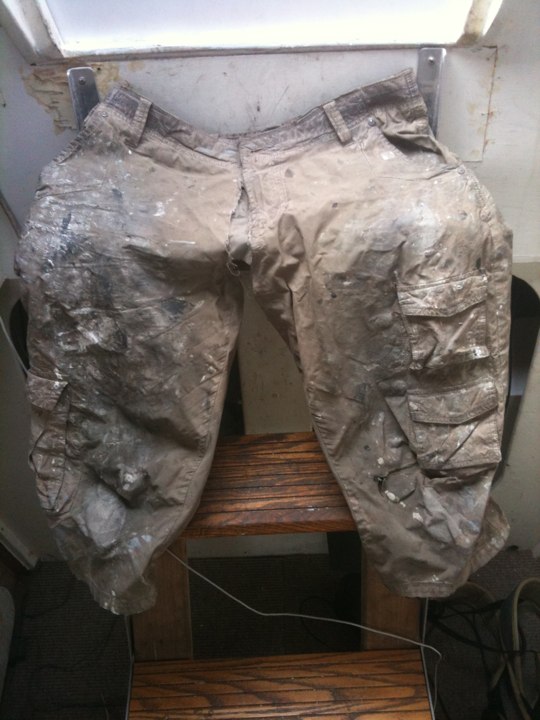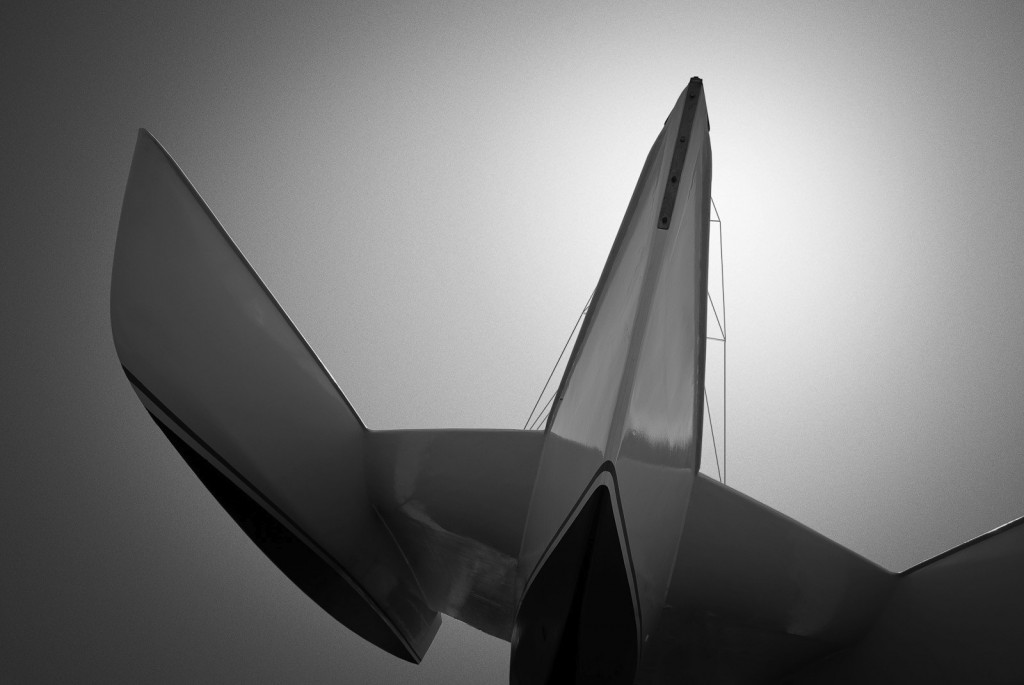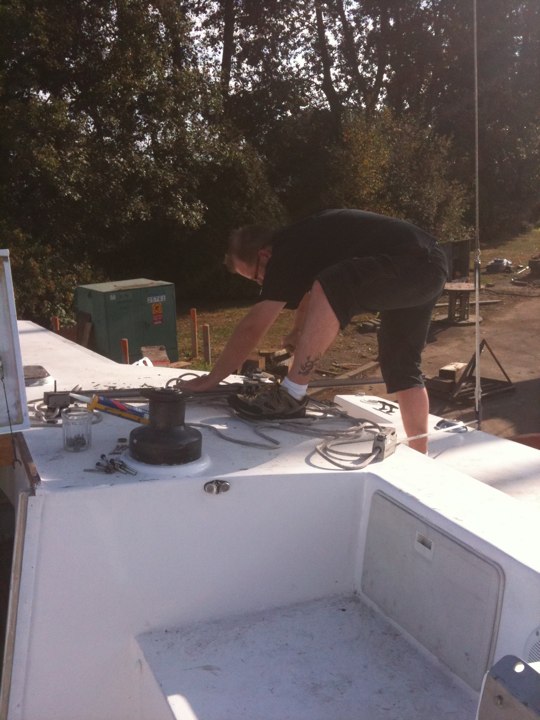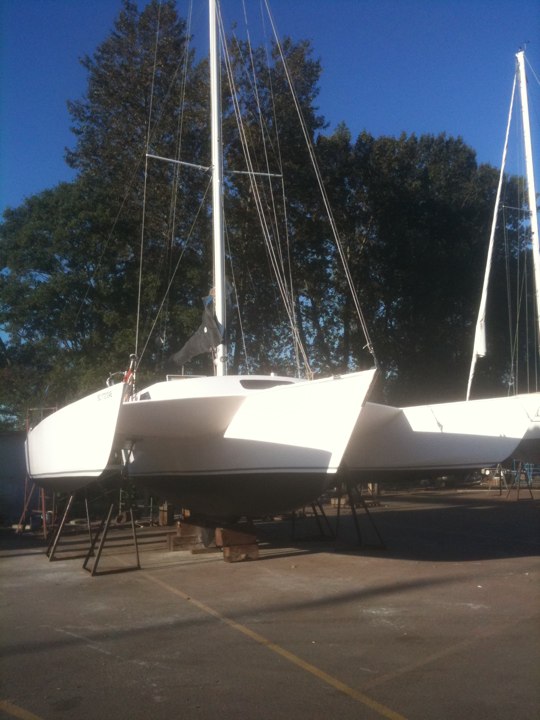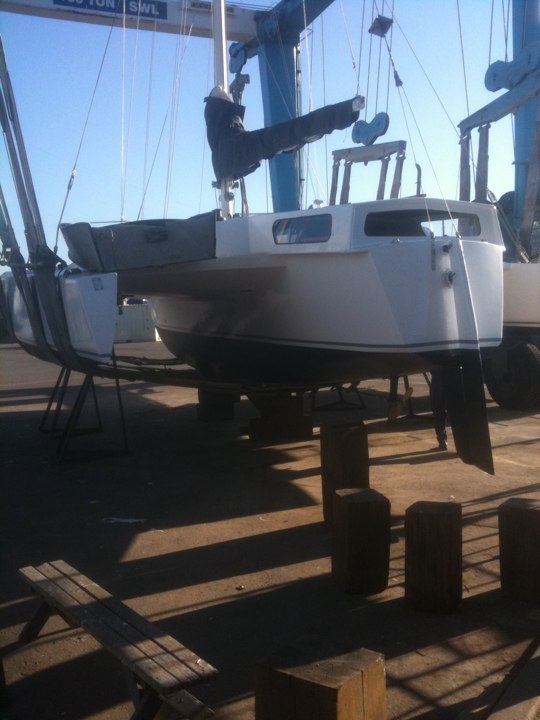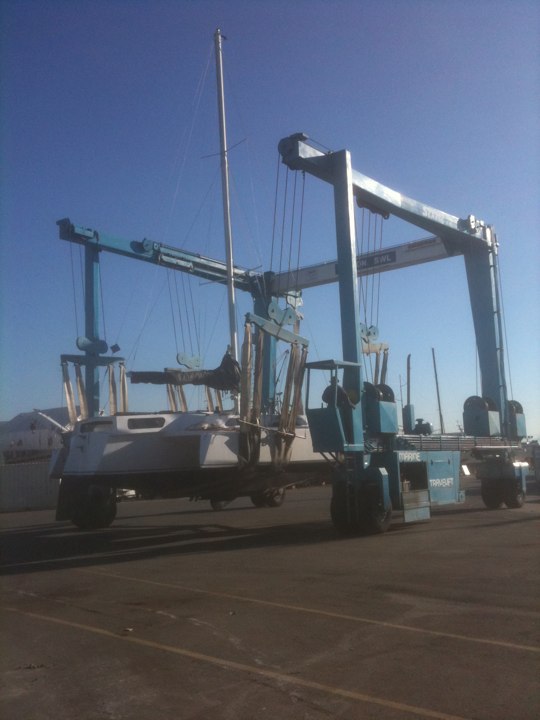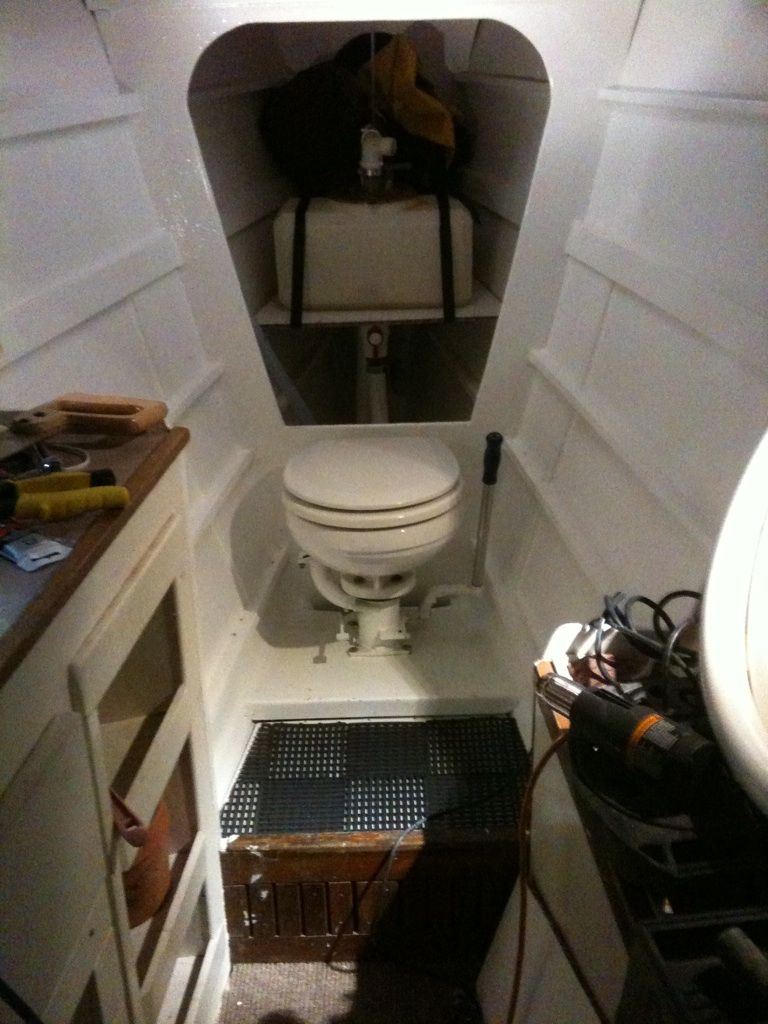Wow, what a busy couple of months!
I’ve been neglecting the blog, which is something I need to remedy. In my defence, I’ve been very very busy. So, in lieu of posting the ten or fifteen posts that I should have been posting all along, I’ll have to just get the queue out in a very condensed fashion.
Returning to the format of the ‘What I Did On My Summer Vacation‘ series of posts, here’s a rapid-fire “clips show” of the last two months.

I started and finished a two-week class in ‘Advanced Diesel Engine Maintenance’, in which we tore the above Yanmar 2QM marine diesel engine completely apart and put it all back together. I’ll probably never take the camshaft out of my Yanmar 3HM, but at least now I’m pretty sure I could if I absolutely had to.
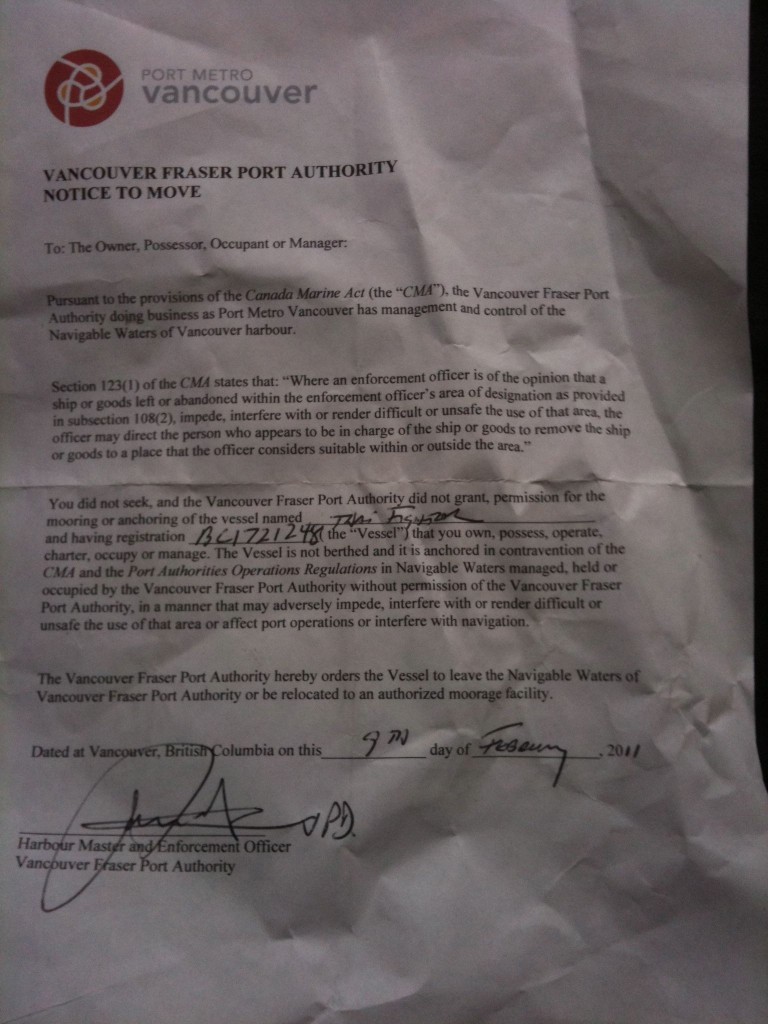
This one warrants a blog post of its own – but then again a lot of these pics do. This is a formal ‘Notice To Move’ from the Vancouver Port Authority, as delivered by the VPD while I was sitting safely and soundly at anchor just off Kitsilano Beach. The officer explained that everyone was getting these notices as an advance move, so that if the Port Authority decided at any point to tow boats out of the harbour and impound them, they could do so without warning. He also explained that the notices were the result of meetings between the City of Vancouver Parks Board and the Port Authority, over just who’s responsibility it was to pay for the cleanup of Kitsilano Beach after anchored sailboats were blown ashore and wrecked in windstorms.
What really bugs me is that since then, talking with other liveaboards here in False Creek, it would seem that this notice was only delivered to abandoned or unattended/derelict vessels left out at the anchorage, and that I was the only liveaboard sailor to receive a notice. Strange, especially since I feel like I’ve proven myself to be a responsible and conscientious mariner, and I have never been blown ashore.
The notice says that I am anchored without having seeked permission to anchor, but as of now the Harbour Master has still not replied to my email requesting permission to anchor. I really do hope that this notice is the first and last interaction I’ll have with the Port Authority, but I can’t help feel a bit of foreboding.
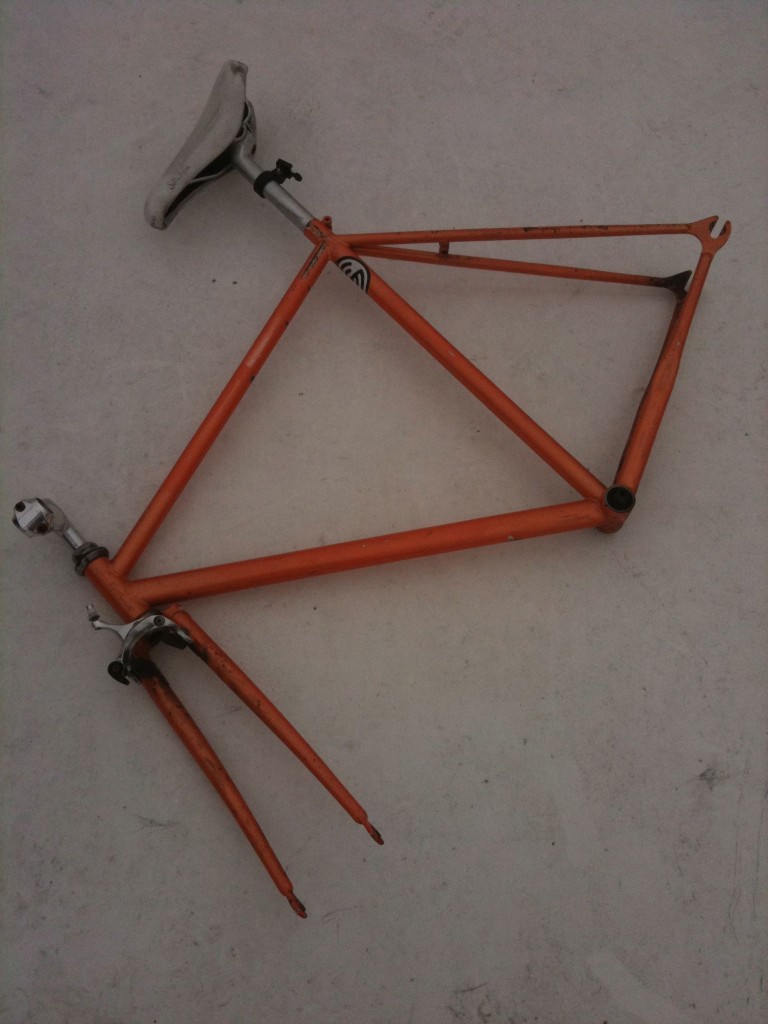
In my ongoing quest to simplify and minimize my life, I finally realized that my beloved bicycle just doesn’t fit “indoors”, and storing the Creamcycle outdoors all winter was slowly killing her. There’s room for a bike in the starboard ama if I arrange things very carefully but that’s a lot of valuable storage space taken up, especially with the prospect of Miya also having a bike aboard. After much research, I decided that the path forward would be to purchase a Montague Boston folding bike, and migrate all of my pro-grade components from the Creamcycle over onto the Boston frame, and vice versa, and then sell the result on Craigslist. More on this soon.
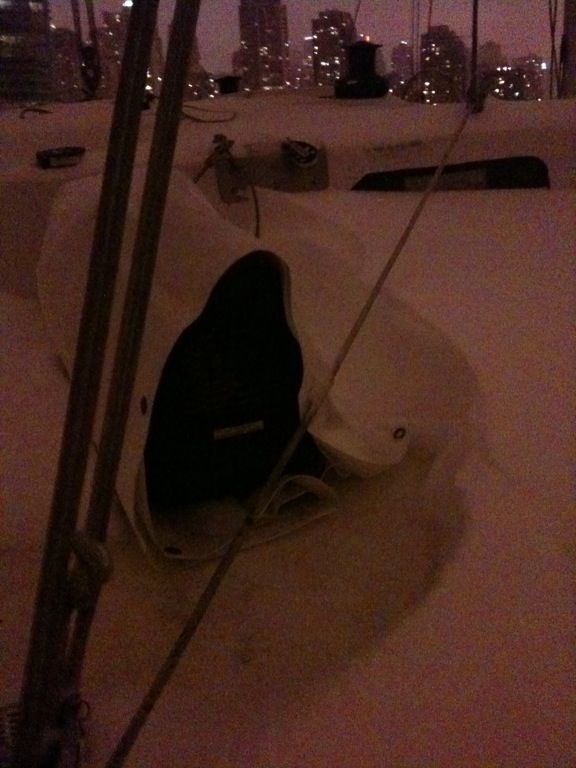
February 26th 2011 brought the first and last big snowstorm of the season. This pic is a little difficult to make out, but if you look closely you can see the snow drifted up nearly over the cabin window, with a melted/windshaped cutout around the Honda EU2000i generator, wrapped here (as always) in a white tarp to keep the weather out.
March 4th was my 35th birthday, and we celebrated by sailing the TIE Fighter across the Georgia Straight and over to Pender Island for a weekend-long multi-birthday party with twenty or so friends in a mansion on the highest point on the island. Seriously swank – a hot tub on the roof, and 360º view of the Gulf Islands!
Miya took this video at a particularly stressful moment during the journey across the Straight – we’d had lovely 10-15kn winds coming out of English Bay, but as we rounded UBC the winds jumped to 20-25kn and we struggled to reef the mainsail, which wasn’t rigged properly for reefing. Shortly after we succeeded, we suddenly lost steering…
The rest of the trip got steadily worse, and by the time we arrived at the west side of the Straight the wind was blowing a steady 30kn with pouring rain and 3m waves occasionally breaking over the decks. We arrived shortly after dark on Friday night, exhausted and happy to be somewhere warm and dry – I don’t think my boots dried until Sunday.
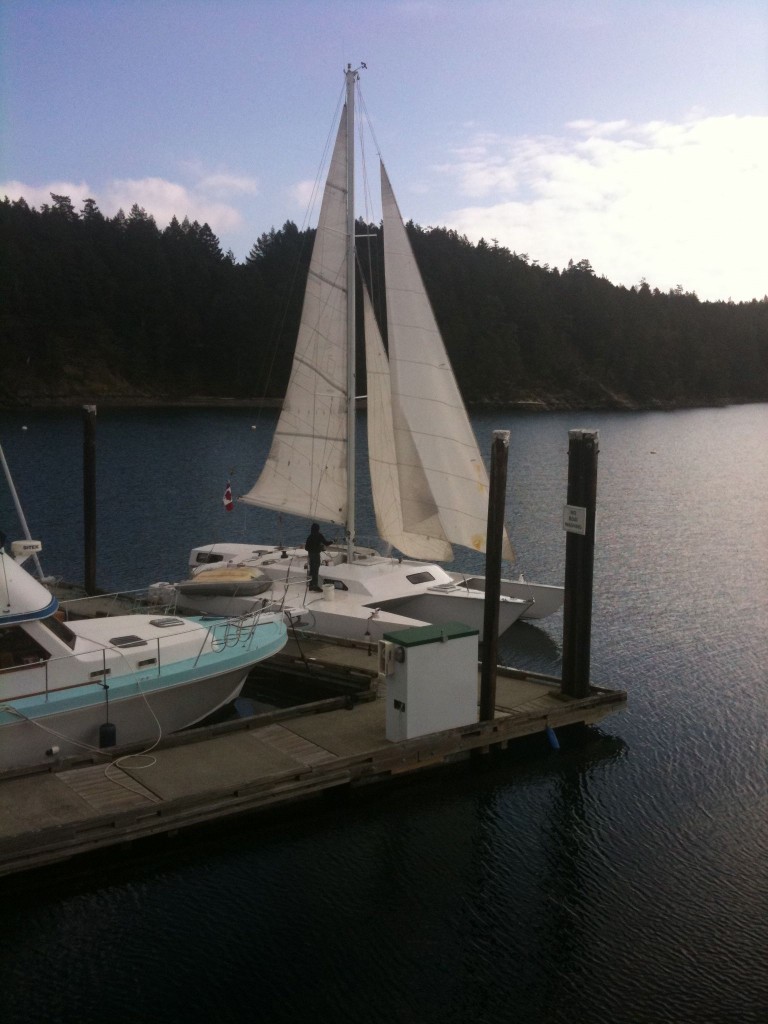
We moored the boat at Otter Bay for the weekend while we relaxed at the mansion. This pic shows Dan Ross spraying down the sails with fresh water, after being soaked with seawater. You really shouldn’t allow sails to sit with salt on them – the salt attracts moisture from the air so the sails will never really dry out completely, which is really bad for the lifespan of the sails, not to mention the probable cause of the large rust stains visible on the headsail.

I picked up a brand new modern battery charger for a little under half price on Craigslist and installed it, finally taking control over the charging of my batteries! Prior to this I had been charging the batteries directly from a 20a DC-DC converter, which is effective but inefficient, and very very hard on batteries. With the new ProNautic C3 50a charger, my time to fully charge the batteries dropped from seven hours to just under three hours. Take note of the mess of wires in the background – this was taken after I had already pulled two full laundry baskets of unused wiring out of the boat. Apparently at least one of the former owners of the TIE Fighter had rewired the boat, but hadn’t bother removing any of the old wiring!

One thing I noticed during the Pender “sea trials” trip was that the winches on the mast had begun slipping. I’ve owned the boat for over three years now and have never serviced the winches, so maintenance was definitely overdue. I had dropped Miya and DR off at Swartz Bay, and TIE Fighter was now anchored in Sidney, BC, so I had my evenings free to work hard on boat projects. Servicing winches is messy work but quite introspective and satisfying, much like I imagine cleaning a rifle must be. This pic shows three of the mast winches disassembled and my first experiments with using ‘Simple Green’ to clean the components. Result: ‘Simple Green’ does not effectively clean winch components.
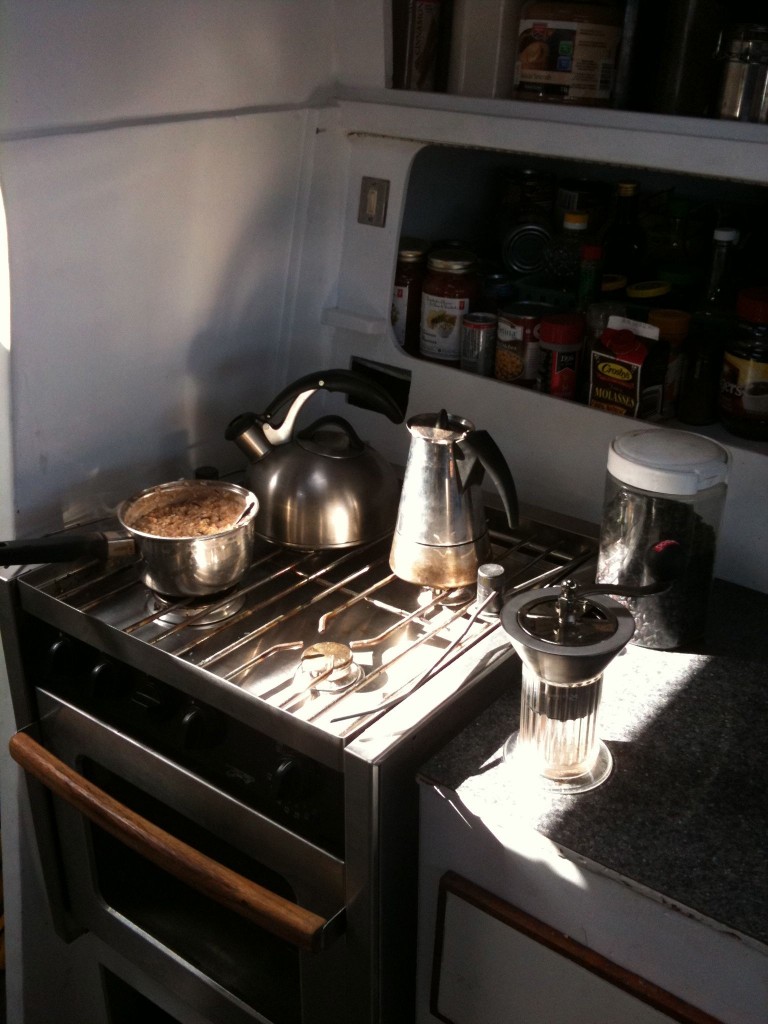
Being anchored in a new place makes me quickly slip into a comfortable routine. I finally got around to repairing the broken Bodum hand-crank coffee grinder that I purchased last fall, and this pic shows my morning ritual in progress – a pot of steel-cut oatmeal and quinoa on the galley stove, with a Bialetti ‘moka pot’ of coffee percolating beside it, lit by a sunbeam.

Yet another project that I’d been putting off; the aft cabin furnace needed a day tank. The hard part about diesel furnaces is that they need to be supplied with diesel fuel at about 3psi – this can be achieved with either a small electric fuel pump, or with a gravity feed from a tank stored at least four feet above the fuel intake. The problem is that as far as I can tell, very few companies make a diesel tank with an outlet port at the bottom of the tank! After researching the costs of having one manufactured (about $300), I found this water tank, rated for chemical storage, at the wonderful Sidney Boaters Exchange for a whopping $8.00. Another $6.00 in parts, fittings and tie-downs and I was in business!
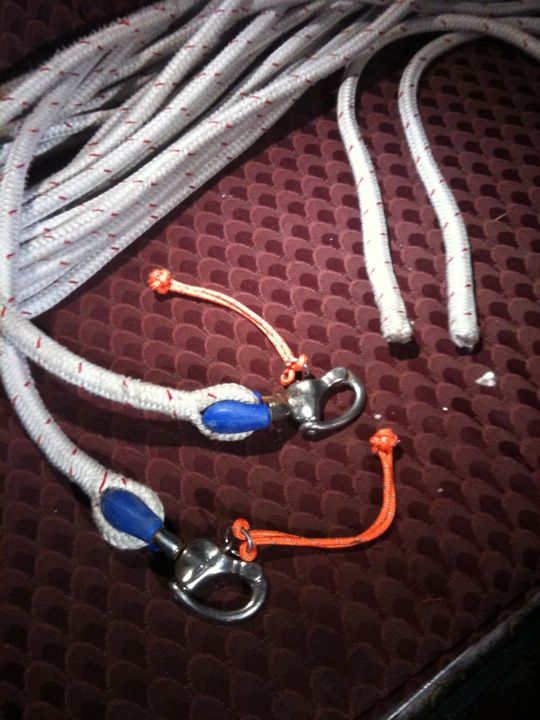
Evenings over the next two weeks were slow and quiet, so I got a few chances to move away from the “needs” projects a little and onto the “wants” projects. Here’s a pic of the snap shackles on the headsail sheets spliced into the sheets instead of tied in with bowline knots, and the bitter ends of the sheets backspliced. This is not only faaaaaar more attractive, but also much smoother for tacking as there is less to catch on the inner forestay while the headsail slips across.

More detail on the winch servicing project; the acetone in the back proved to be a failure as well. At some point a previous owner had serviced the winches by putting grease on the pawls. Apparently – and this was news to me – putting grease on pawls is a no-no, as the grease tends to thicken and build up, eventually causing the pawls to jam. For reference, you should only ever put oil on winch pawls; grease is fine (and recommended) for the gears, but the pawls only ever get oil.
The thick, gummy grease is difficult to get off of the components, but the ultimate solution turned out to be very simple: diesel fuel dissolves the grease and an old toothbrush cleans off the remainder. The glass and tupperware in the pic above are both full of diesel, stained an ugly greenish-black by the dissolved grease after soaking the components overnight.

While I had the winches apart, I took the opportunity to purchase a ‘rebuild kit’ from the local marine store, and replaced all of the pawl springs in each winch. In this pic, the silver chicklet-looking chunky steel bits are the pawls, which are held against the gear sprockets by the little flat circular pawl springs, which causes the characteristic clatter of the winch in use. Pawl springs wear out over time, but after cleaning the winches and replacing all the springs, my mast winches now work just like new.
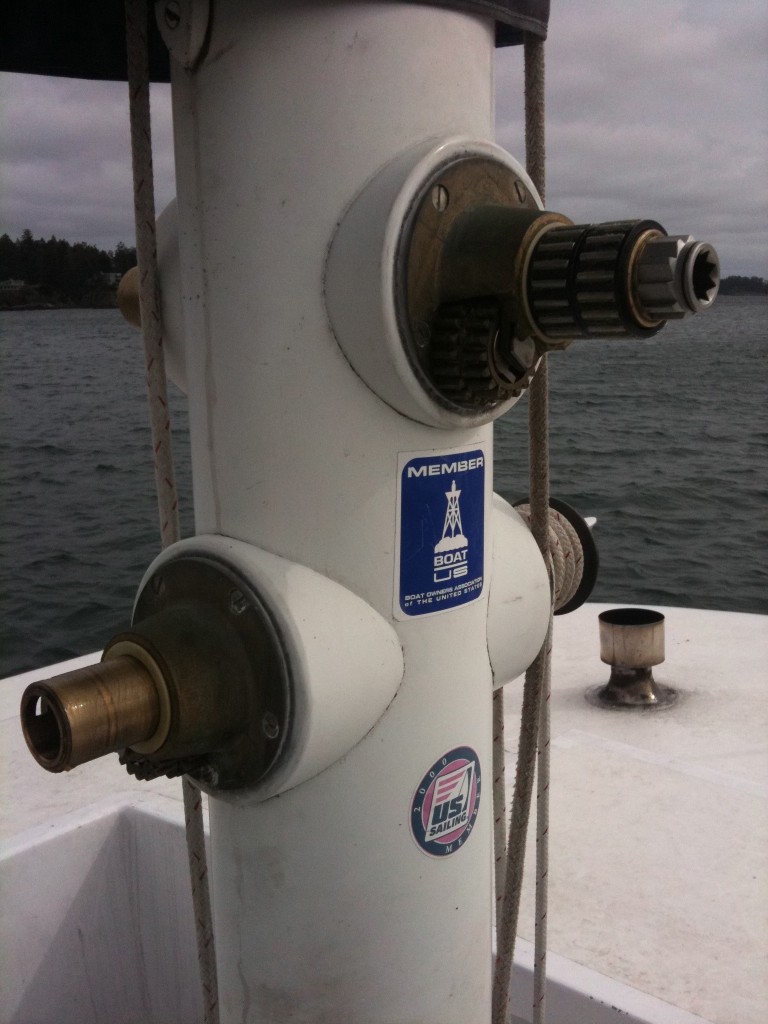
The winch mounts during reassembly, after cleaning with diesel, brushes and paper towel. During this procedure it was so bitterly cold outside that I had to go back into the cabin after cleaning each mount to rub my hands together to regain feeling in my fingertips!
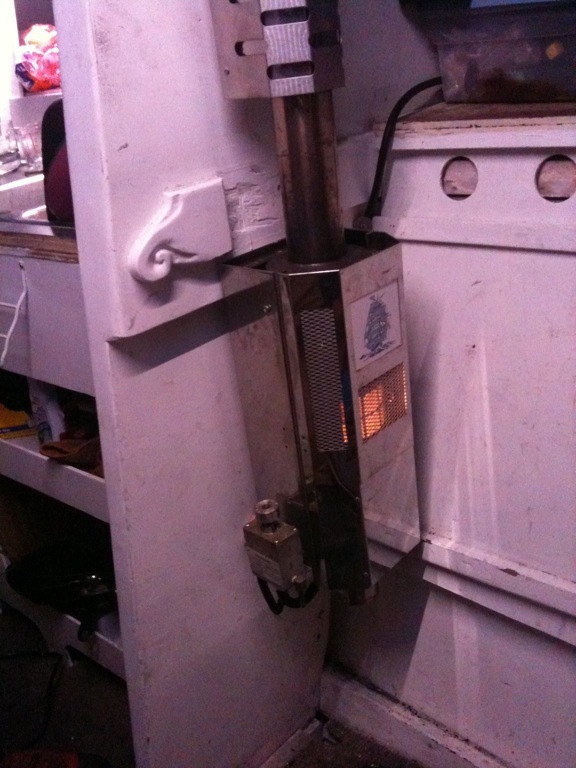
The aft furnace was critical during this period – prior to having the furnace working I was mostly confined to the forward cabin for pretty much everything except cooking, working my day job from either my bed or the “guest nest”, which is what Miya has named the port-side single berth.
Upon first lighting of the new furnace, I nearly burned the boat down! It started up just like normal and worked great, but shortly after this photo the furnace began making a “chuffing” noise and the walls of the burn chamber started glowing red hot – I quickly shut it down, but it kept burning for a good five minutes afterwards. Apparently the diesel metering valve had been set for a much more viscous fuel, and when I measured and tuned the meter it was delivering more than three times the normal amount of fuel to the burner. Since the tuning the furnace has worked 100% as expected, keeping the aft cabin warm for days on end.
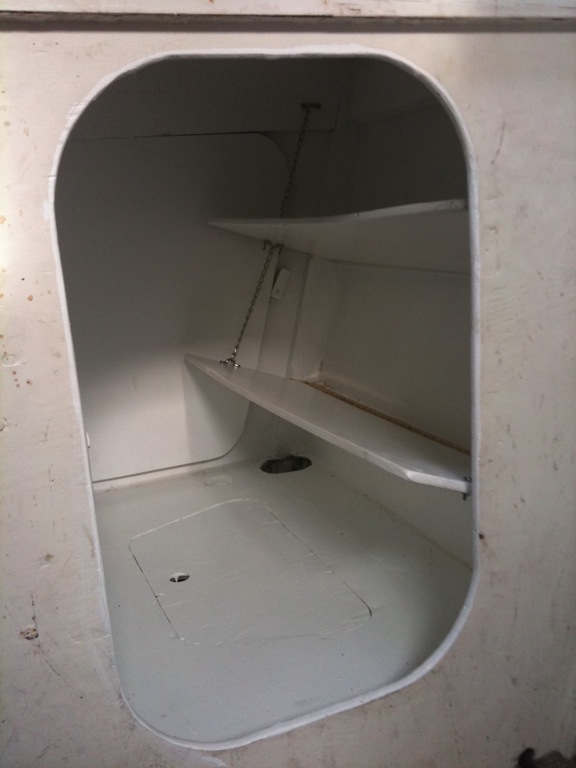
Speaking of the “guest nest”, here is a pic of the newly-painted and newly-shelved cubby below the port side berth, which Miya has named ‘the boudoir’, and we’ve decided is her personal storage area while she’s living aboard with me. My personal storage space is the opposite cubby, which I have dubbed ‘the study’.
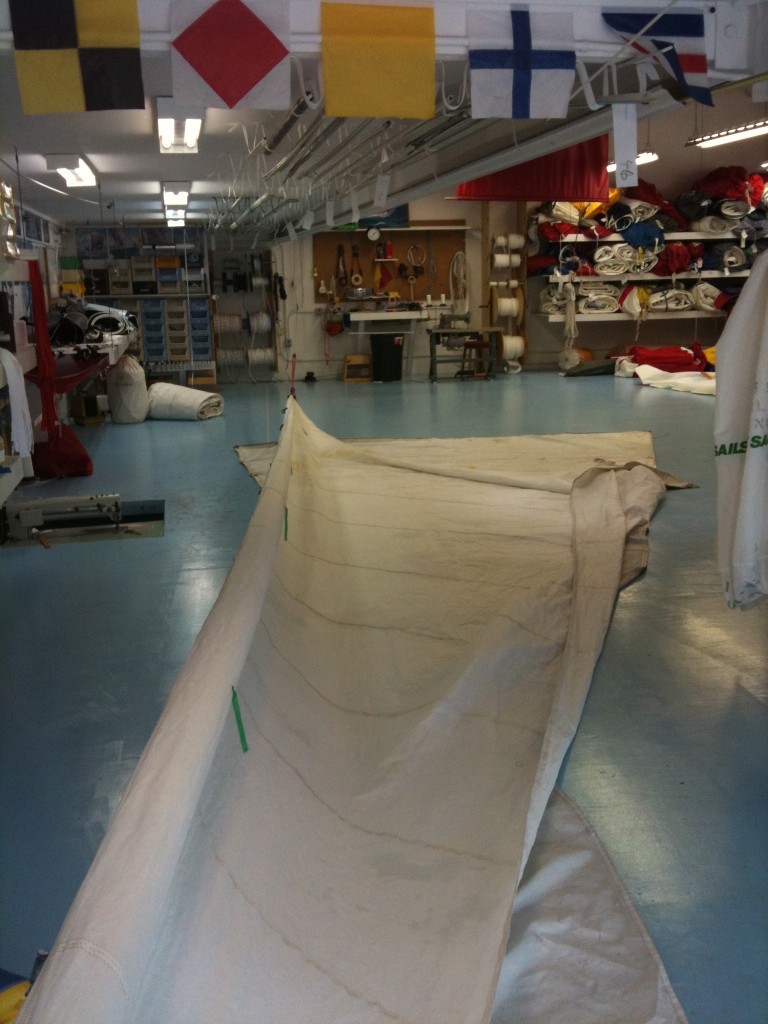
In the sail across from Vancouver, we tore the mainsail in no less than five places, mostly due to poor reefing skills but probably the fact that the sail is fifteen years old might have something to do with it. I brought the sails in to Sidney’s Leitch and Mcbride sailmakers to have it repaired and to get a quote on a replacement sail. I was impressed with their workmanship and attention to detail, and by the personal service I received – they even picked me and the sails up from the boat, and dropped me off again afterwards.
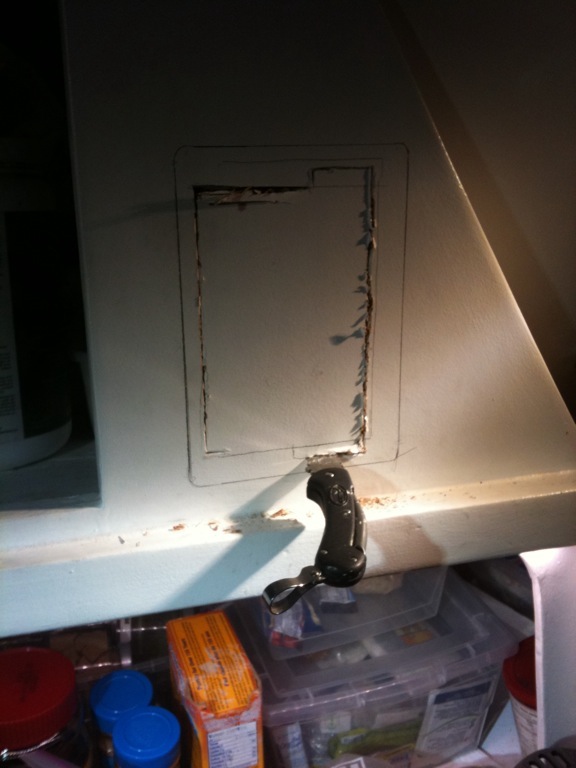
The biggest project of all, while living at anchor in Sidney, was to gut and replace the entire electrical system of the boat. This meant making final decisions on the organization and placement of the switch panels, and cutting into the walls of the cabin to install them. Here I’ve discovered that the panel above the stove is only 1/4″ plywood, and that I’m able to cut through it quite easily with my pocket knife.
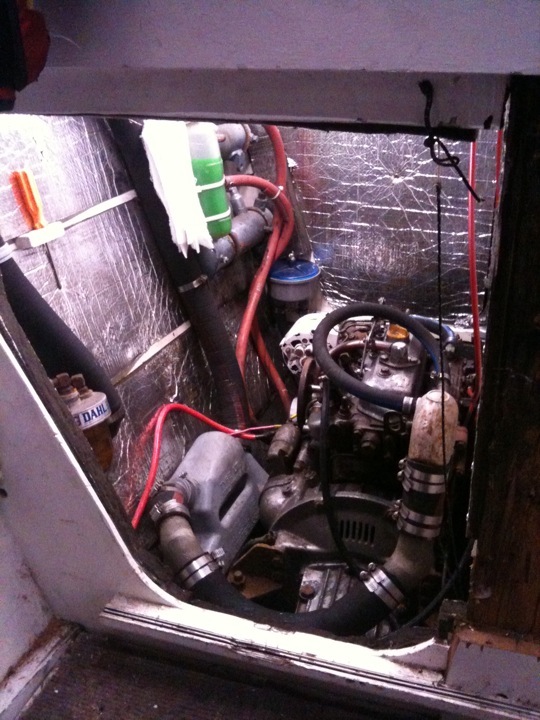
As a part of the electrical system upgrade, I installed LED lighting into all of the under-cockpit cubbies, with the engine compartment getting extra attention as it’s probably the one where having good lighting is the most critical. Amazing how much cleaner Maude looks with good lighting!
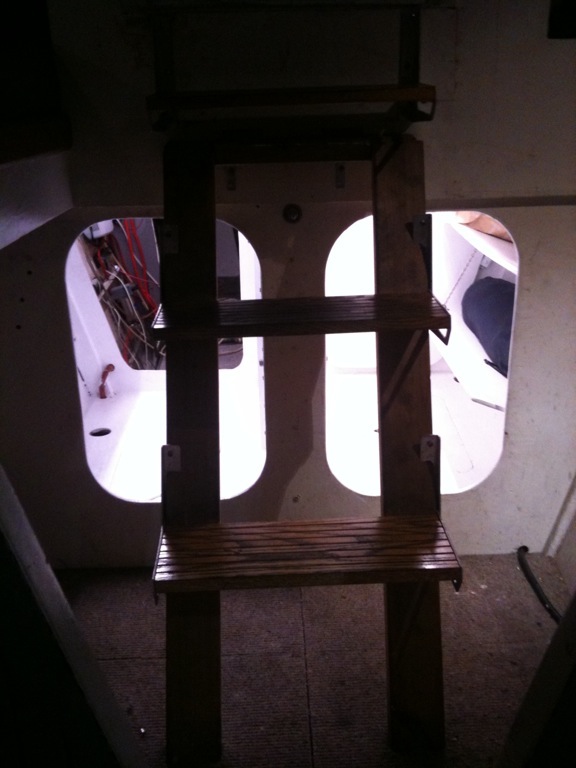
The forward cabin cubbies – the ‘study’ and ‘boudoir’ – shown lit up brightly with the new LED cubby lighting system. What a phenomenal difference it makes, having these formerly dark and dirty spaces now clean, white and bright.
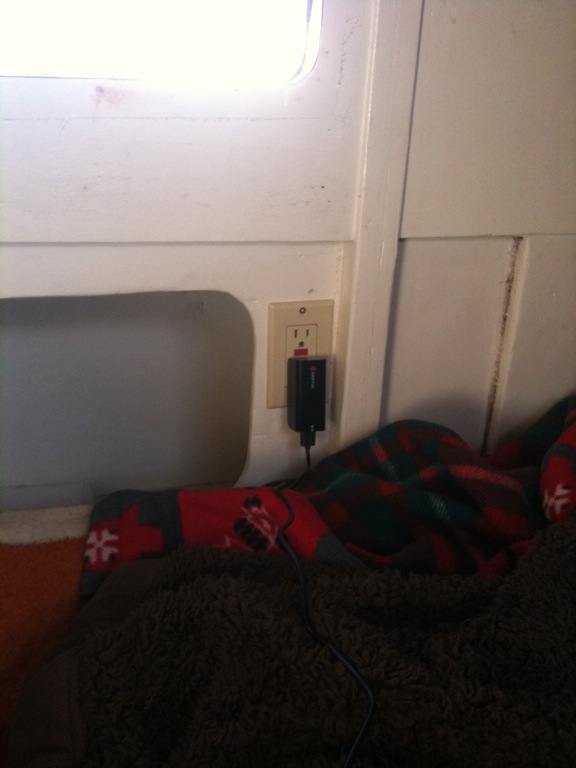
I only have a 400w inverter on the boat currently, but that’s more than enough to run things like laptops and cellphone chargers – I really don’t have much else to plug in anymore! Still, it’s nice to have the convenience of being able to plug things in wherever you are, so I’ve installed GFCI outlets all over the boat. This one is only temporary – I’ve replaced it already with a more modern outlet that has a green LED, so that you can tell at a glance whether or not the inverter is turned on.
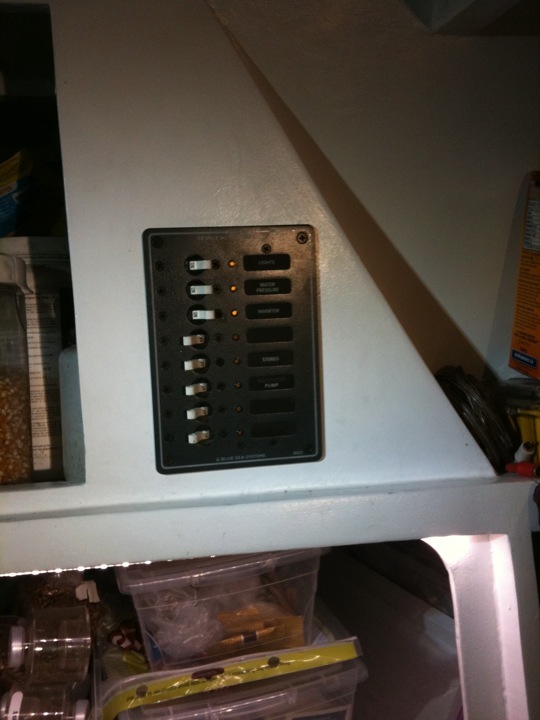
The galley electrical panel installed and active! I’ve since also added a backlighting kit to this panel, so the panel labels glow a soft green at night. It’s the little touches that really make the work feel professional, and give me great pride in having done it all myself.
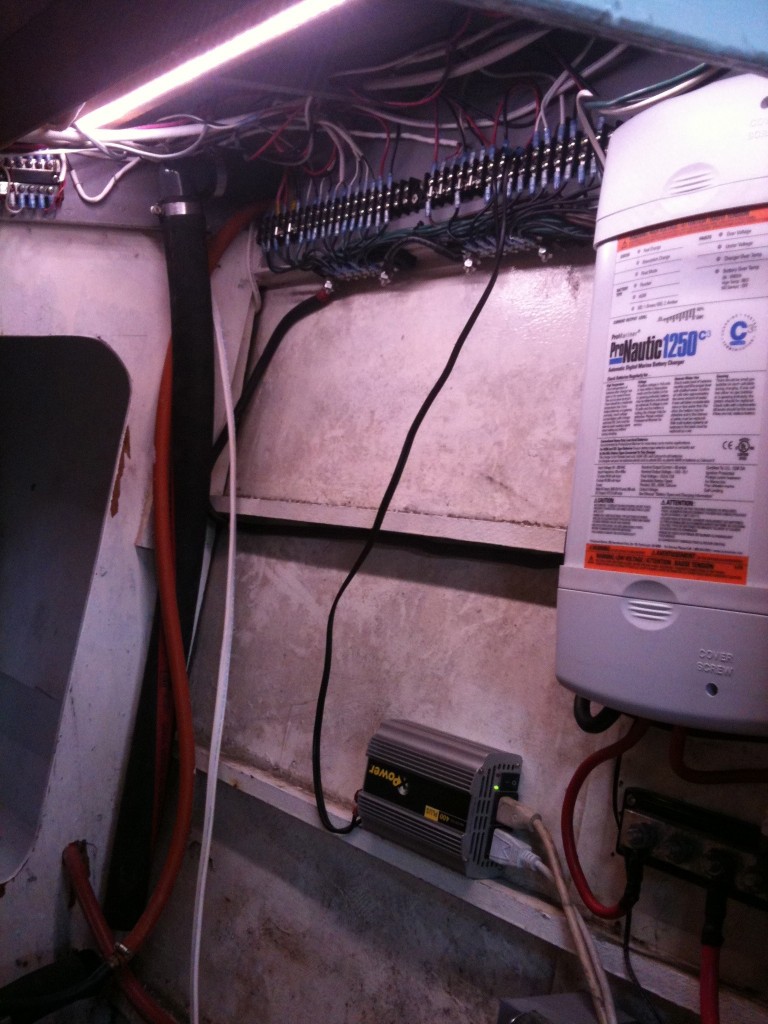
I’m very proud of my wiring job – apparently fifteen years of being a network tech has some boat benefits after all! All wires to the switch panels are cut to length and terminate in double-crimped flanged spade connectors on terminator bars, all grounds are bussed together with appropriately-sized wiring, and every subsystem on the boat has an individual circuitbreaker. TIE Fighter now has a modern, well-installed electrical system, onto which I can build with confidence. Next steps: a much larger battery bank, then a powerful solar array and possibly a wind generator. The “grid” just keeps getting further and further behind me.

On yet another trip to the Sidney Boater’s Exchange I found a pair of nearly-new horizontally-mounted propane tanks for $100 each. This was a great deal, as used horizontal tanks are very hard to find, and new ones are over $400 each – my propane locker can fit two twenty-pound propane tanks, but they have to be horizontal tanks, standard vertical tanks (like on a barbeque) are too tall for the locker. Packing a propane tank home on my bicycle garnered some strange looks from the locals.

I also picked up a Xantrex LinkLITE battery monitor, which conveniently fit into the hole from the ancient (and dead) Heart Interface battery monitor that was installed on TIE Fighter when I purchased her. Yet another step towards complete mastery of my electrical system – a former boss of mine was fond of saying “that which gets measured, gets managed”. This is absolutely true with regards to battery life; I can now measure how much electricity the boat is using at any given moment, and know at a glance how much battery life I have left before I have to run the generator to charge back up again.

After three solid weeks of heads-down work on the boat, a vacation was in order. Miya’s close friend and cousin Stacee was getting married in Puerto Rico, and Miya was the maid of honour so I was invited along as her date. We flew to Vieques, a small rustic island about an hour east of San Juan. Vieques is known for beautiful beaches, quiet towns and a large population of unfenced horses running free over the whole island. At times I really felt like I was back living in Costa Rica again, and within the week my spanish came rushing back to me.
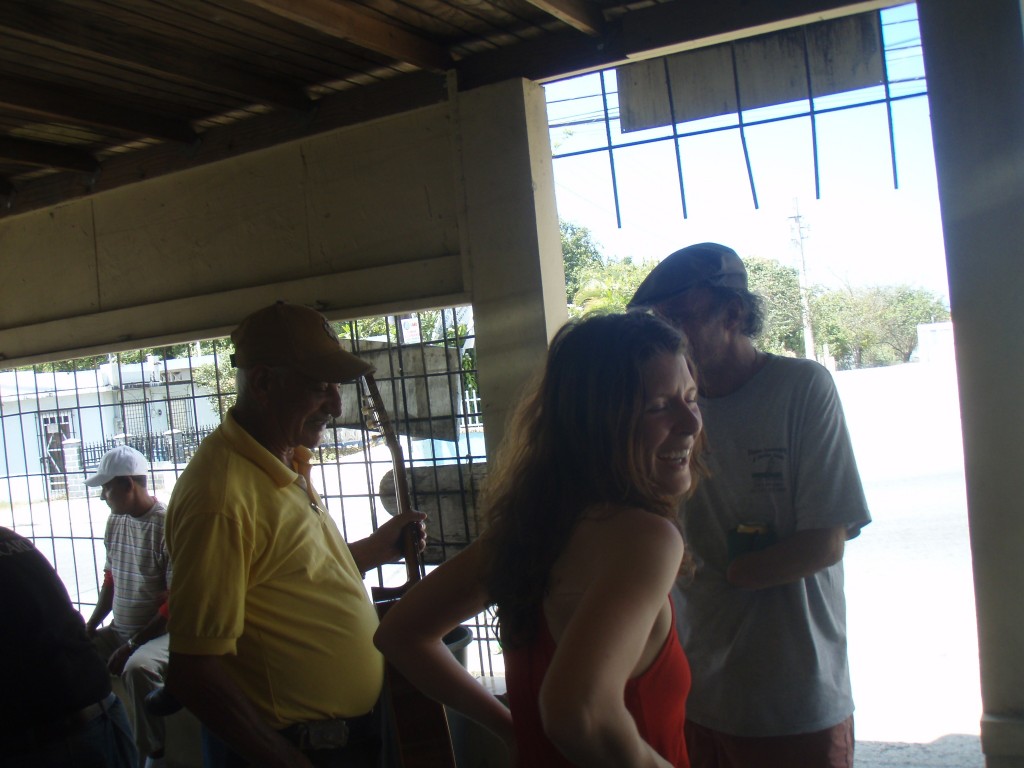
At some point, walking from our budget hotel towards the posh resort the wedding was being held in, we were flagged down by pensioners in a small bar by the side of the road, invited in for a drink and to listen to the locals playing music and gabbing. Here Miya has just been serenaded with very decent spanish folk music by the man on the left, and the one-armed man on the right had just finished telling her the story of his being stabbed in the abdomen two nights earlier, on the street a block from our hotel.

We took advantage of the tourist industry on Vieques and signed up for a one-day ‘Explore SCUBA’ course, which took us out to the end of an unused (but heavily secured) military pier for a pair of dives. The waters under the pier were teeming with life, and I discovered to my great relief that the sinus and inner-ear problems that plagued me as a youth have not in fact followed me into adulthood – I am able to dive after all.
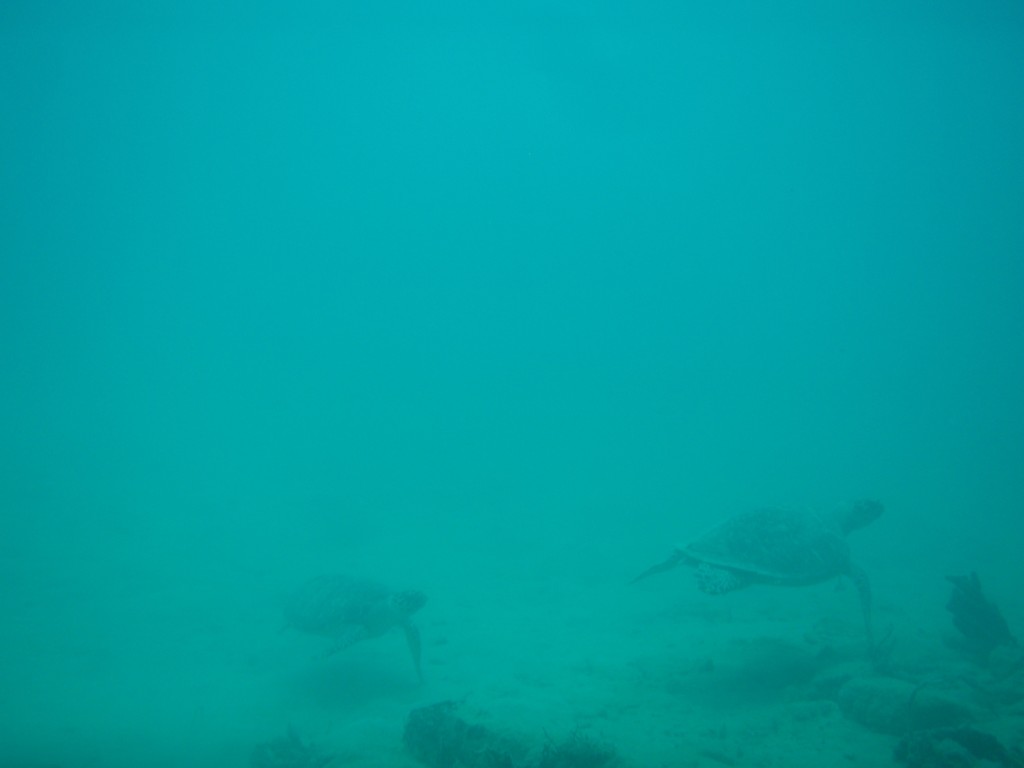
I’ve included this pic because I think it makes an excellent desktop wallpaper; subtle and not too busy. Click the pic – or for that matter, any of these photos – for a higher-resolution version. We saw many sea turtles, as well as several types of ray and many, many different tropical fish.
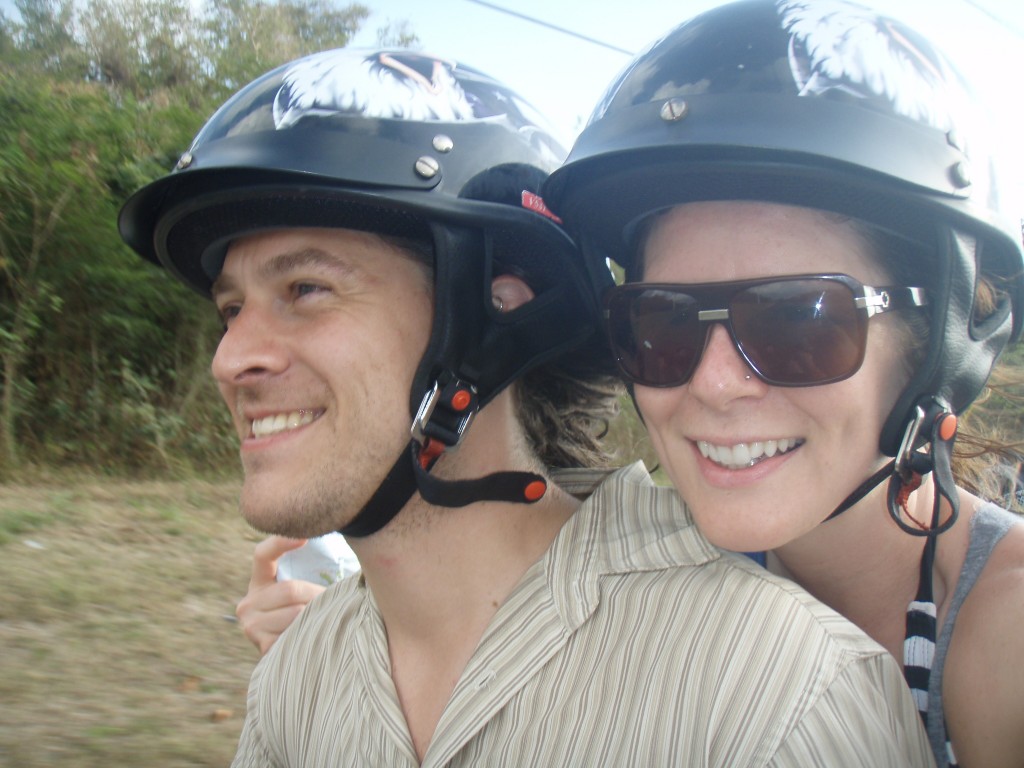
Vieques is fairly small at only about seven miles long, but we soon felt the pangs of not having our bicycles. Renting bikes was an option, but at $25/day per bike renting a motor scooter for $50/day seemed like a much better option. In the three days we had the scooter the island was opened up to us in a way that was impossible on foot, and we explored the tiny back roads of the island.
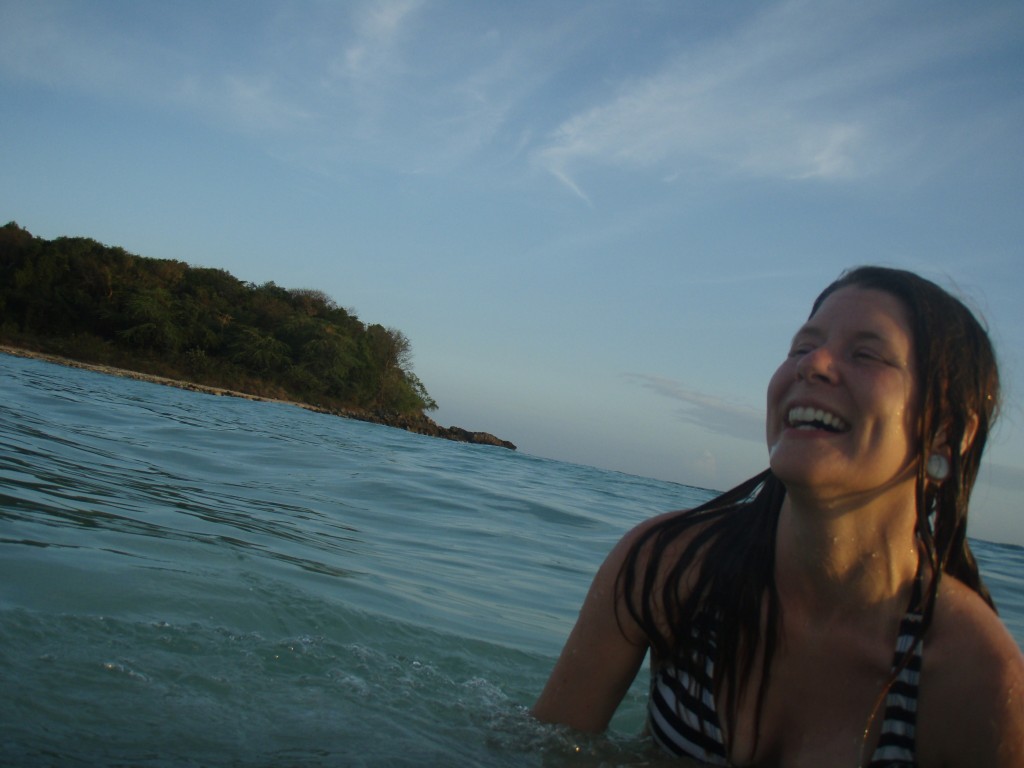
There’s something about the sunshine that makes everything a little easier to take… after a few days on the beach it was difficult to remember why we’d been so stressed out about all the little things back home. This pic was taken at the “red beach”, on our way back from the “green beach”, where we’d discovered that tiny, vicious gnats come out in swarms as the sundown approaches. Miya was strangely unaffected, but bites covered my arms in itchy red welts that lasted for several days.
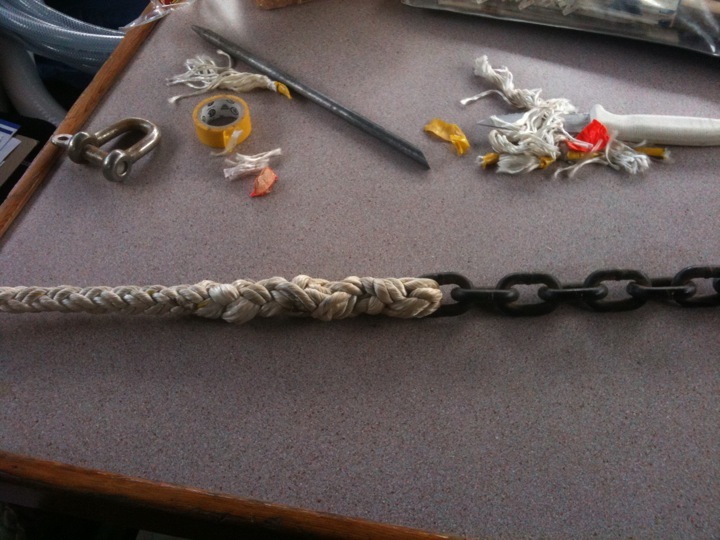
A month or two ago I visited Miya in Seattle and picked up a 150′ length of gorgeous barely-used eight-plait nylon anchor rode at Second Wave, yet another marine consignment store. I think I might be getting addicted to used sailing equipment – this 3/4″ nylon rode was a great deal though, at $50 for 150′, compared with $1.60/foot locally! I spliced the rope to a 40′ length of 5/16″ heavy steel chain, and this splice is currently holding me at anchor quite handily.

On April the 6th, I left Tsehum Harbour and headed back towards Vancouver. I missed my tide window for Active Pass that day – with a sailboat you can only traverse the pass at slack tide, and slack tide was at 1pm. I ended up sailing slowly up the Trincomali Channel and spending the night in Montague Harbour, which is a lovely anchorage but in a complete cellular reception black hole, ruling out any extended stay. In the morning I packed up and headed out through Porlier Pass to begin my solo crossing of the Georgia Straight.

The weather for the first days sail was a mix of sun and rain, with long periods of spring-like warmth followed by cold rains and wind. This rainstorm followed me up the channel for several hours, but when it finally caught up with me late in the afternoon it turned out to be an unexpected hailstorm!
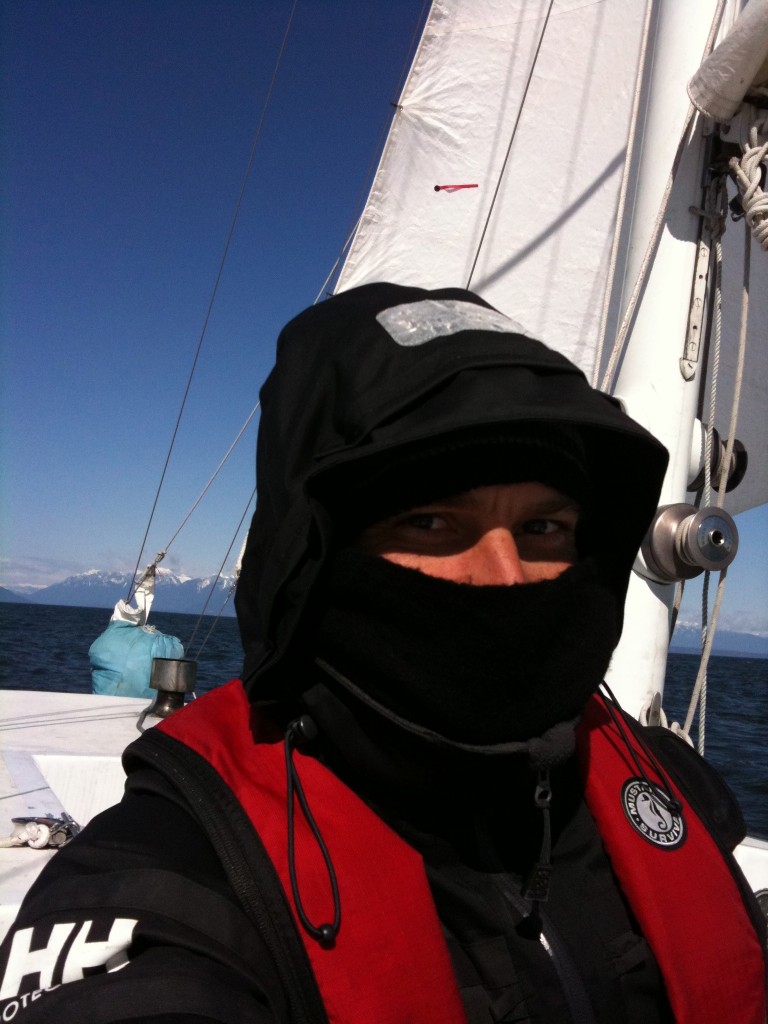
The only real downside to sailing in cold weather is the long periods of inactivity, requiring you to basically sit outside in the cold wind for hours on end with nothing to do. Even with proper foul-weather gear, two layers of wool sweaters and wool hats and gloves, it’s still freezing. Pair that with the inexplicable lack of a fly on my overall-style foul-weather pants, and the only real movement you have for the vast majority of the journey is the occasional trip indoors to pretty much completely disrobe to pee. Still, apart from the puzzling lack of zipper, I am completely pleased with my Helly Hansen foul weather gear.
Here’s a video, taken once everything had calmed down and I was moving steadily forward. After I came through Porlier Pass I was expecting some heavy winds and probably some waves, but the addition of the tidal surges from the pass made for some very, very stressful moments! I got my second reef into the main, but not before stuffing all three bows into the waves several times, strewing tools from one end of the cabin to the other, and spilling the contents of my cupboards all over the floor, breaking a bunch of dishes and making an awful mess. The rest of the trip across was spent with the double-reefed main and staysail, which I finally shook out near UBC. I made an average of about 6kn across the Straight, but once I got the headsail up in more protected waters I reached 9.2kn coming into English Bay.
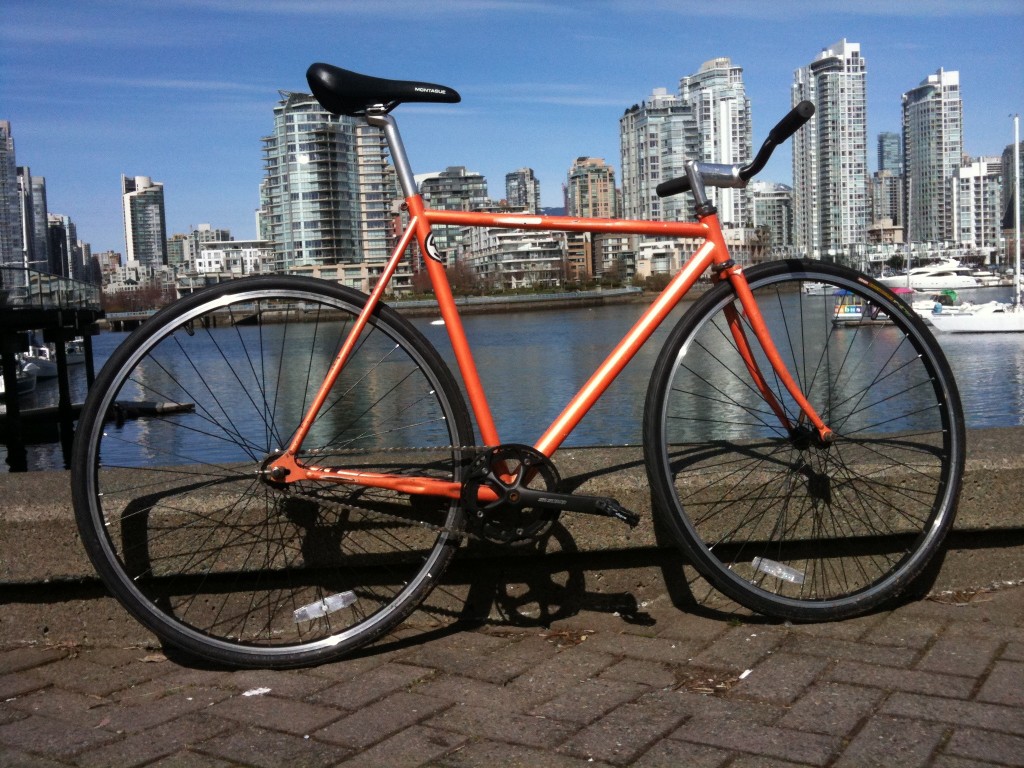
This is the “new” Creamcycle, built up as a fixie with all the brand-new components from the Montague bike and listed for sale on Craigslist. Do you know anyone looking for a rad (if well-used) bike for the summer? 🙂
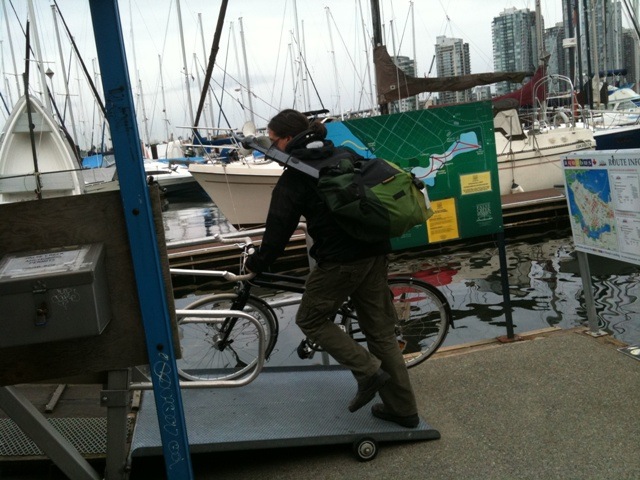
Yet another class with the Bluewater Cruising Association; this time an outboard motor repair and maintenance class. Here it is Saturday morning at 8am, leaving on my bicycle with the heavy outboard in my backpack.
The outboard, we like to say, “worked really great until it didn’t”. In Sidney, during a trip to shore, the outboard very suddenly quit with no warning, in the sort of way that makes you think something is very, very wrong. Reading up a bit on the internet, I found out that you’re supposed to change the gearbox oil regularly, which I hadn’t – though apparently when you go to drain the gearbox oil it’s supposed to be oil, not dirty water and metal filings.

Sitting in class, we learned all about the workings of outboards, stripping out sparkplugs and taking apart carburetors, and I slowly dug down into the problem that had caused the outboard to stop so suddenly. Clearly the problem was in the gearbox, but could it be repaired?
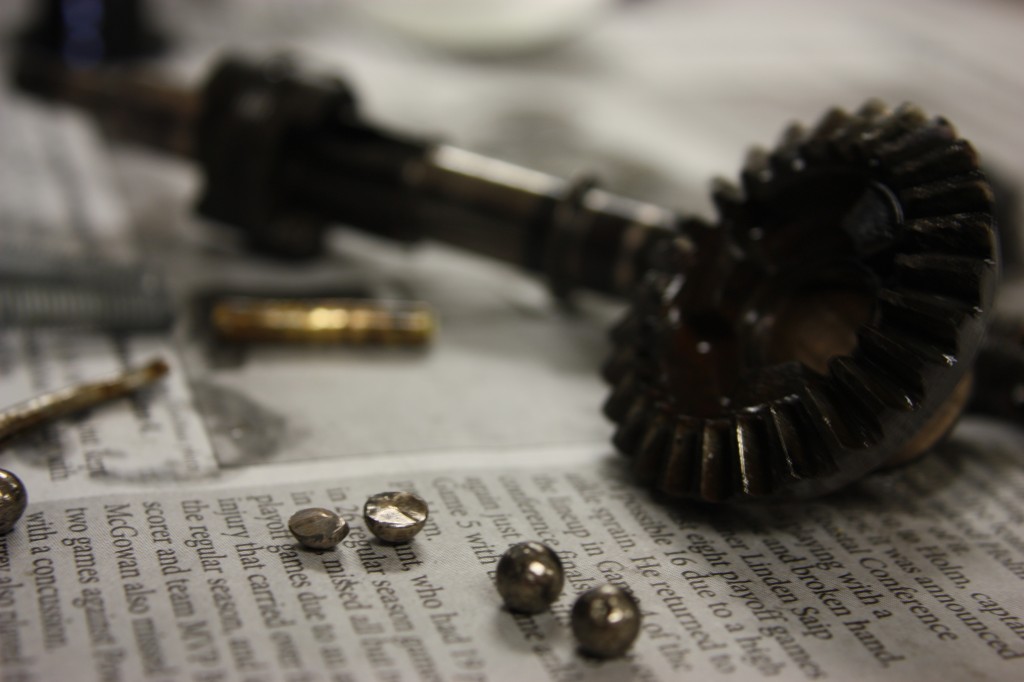
When I finally got the gearbox opened up and stripped, a few pieces fell out – and some of those pieces were ball bearings. Well – I use the word “ball” somewhat loosely there; the parts that fell out were anything but spherical. D’oh!
End result? The engine is apparently a write-off. I can probably get a few bucks on Craigslist for it, for parts – but the cost of the replacement bits to get her running again are approximately four times what I paid for the engine originally, and given that it was quite underpowered for the dinghy it was on anyway, I guess I’m now in the market for a good used 8hp motor.

Lastly, I finally added in and plumbed the third 100-liter water tank to the freshwater system. This has been on the bench for a while, but now the freshwater system is pretty much 100% complete – there’s still a slow, weeping leak on the galley sink that I need to tend to, causing the water pressure pump to kick in about once an hour to keep the pressure up. As far as I can tell the only fix for that is to replace the whole faucet assembly it hasn’t really been high up on my list of priorities.
—
Phew! And that brings us pretty much up to current! So many updates, with so little time. I’ve got to remember to try to spew this stuff out in smaller portions, but when things are moving fast it’s really tough to keep up.





